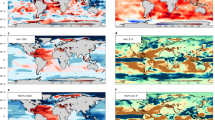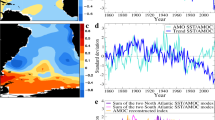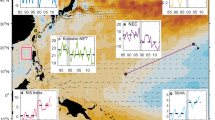Abstract
Climate projections suggest a weakening or collapse of the Atlantic Meridional Overturning Circulation (AMOC) under global warming, with evidence that a slowdown is already underway. This could have significant ramifications for Atlantic Ocean heat transport, Arctic sea ice extent and regional North Atlantic climate. However, the potential for far-reaching effects, such as teleconnections to adjacent basins and into the Southern Hemisphere, remains unclear. Here, using a global climate model we show that AMOC collapse can accelerate the Pacific trade winds and Walker circulation by leaving an excess of heat in the tropical South Atlantic. This tropical warming drives anomalous atmospheric convection, resulting in enhanced subsidence over the east Pacific and a strengthened Walker circulation and trade winds. Further teleconnections include weakening of the Indian and South Atlantic subtropical highs and deepening of the Amundsen Sea Low. These findings have important implications for understanding the global climate response to ongoing greenhouse gas increases.
This is a preview of subscription content, access via your institution
Access options
Access Nature and 54 other Nature Portfolio journals
Get Nature+, our best-value online-access subscription
$29.99 / 30 days
cancel any time
Subscribe to this journal
Receive 12 print issues and online access
$209.00 per year
only $17.42 per issue
Buy this article
- Purchase on Springer Link
- Instant access to full article PDF
Prices may be subject to local taxes which are calculated during checkout






Similar content being viewed by others
Data availability
The ERA5 data used in the study can be downloaded from the Copernicus Climate Change Service (C3S) Climate Date Store (https://cds.climate.copernicus.eu/). The CMIP data analysed can be downloaded from the Earth System Grid Federation portal (https://esgf-node.llnl.gov/). Data generated from the coupled climate model simulations can be downloaded from ref. 66.
Code availability
Python scripts used for the analysis described in this study can be obtained from B.O.P. on request.
References
Buckley, M. W. & Marshall, J. Observations, inferences, and mechanisms of the Atlantic Meridional Overturning Circulation: a review. Rev. Geophys. 54, 5–63 (2016).
Vellinga, M. & Wood, R. A. Global climatic impacts of a collapse of the Atlantic Thermohaline Circulation. Clim. Change 54, 251–267 (2002).
Cheng, W., Bitz, C. M. & Chiang, J. C. H. in Ocean Circulation: Mechanisms and Impacts—Past and Future Changes of Meridional Overturning (eds Schmittner, A. et al.) 295–313 (American Geophysical Union, 2007).
Zhang, R. & Delworth, T. L. Simulated tropical response to a substantial weakening of the Atlantic Thermohaline Circulation. J. Clim. 18, 1853–1860 (2005).
Clement, A. C. & Peterson, L. C. Mechanisms of abrupt climate change of the last glacial period. Rev. Geophys. 46, RG4002 (2008).
Rahmstorf, S. Ocean circulation and climate during the past 120,000 years. Nature 419, 207–214 (2002).
Clark, P. U., Pisias, N. G., Stocker, T. F. & Weaver, A. J. The role of the thermohaline circulation in abrupt climate change. Nature 415, 863–869 (2002).
Rahmstorf, S. et al. Exceptional twentieth-century slowdown in Atlantic Ocean overturning circulation. Nat. Clim. Change 5, 475–480 (2015).
Caesar, L., Rahmstorf, S., Robinson, A., Feulner, G. & Saba, V. Observed fingerprint of a weakening Atlantic Ocean overturning circulation. Nature 556, 191–196 (2018).
Bryden, H. L., Longworth, H. R. & Cunningham, S. A. Slowing of the Atlantic meridional overturning circulation at 25° N. Nature 438, 655–657 (2005).
Sun, C. et al. Atlantic Meridional Overturning Circulation reconstructions and instrumentally observed multidecadal climate variability: a comparison of indicators. Int. J. Climatol. 41, 763–778 (2021).
Collins, M. et al. in Climate Change 2013: The Physical Science Basis (eds Stocker, T. F. et al.) 1029–1136 (Cambridge Univ. Press, 2013).
Manabe, S. & Stouffer, R. J. Two stable equilibria of a coupled ocean–atmosphere model. J. Clim. 1, 841–866 (1988).
Bakker, P. et al. Fate of the Atlantic Meridional Overturning Circulation: strong decline under continued warming and Greenland melting. Geophys. Res. Lett. 43, 252–12,260 (2016).
Liu, W., Xie, S.-P., Liu, Z. & Zhu, J. Overlooked possibility of a collapsed Atlantic Meridional Overturning Circulation in warming climate. Sci. Adv. 3, e1601666 (2017).
Boers, N. Observation-based early-warning signals for a collapse of the Atlantic Meridional Overturning Circulation. Nat. Clim. Change 11, 680–688 (2021).
Eyring, V. et al. Overview of the coupled model intercomparison project phase 6 (CMIP6) experimental design and organization. Geosci. Model Dev. 9, 1937–1958 (2016).
Golledge, N. R. et al. Global environmental consequences of twenty-first-century ice-sheet melt. Nature 566, 65–72 (2019).
Levang, S. J. & Schmitt, R. W. What causes the AMOC to weaken in CMIP5? J. Clim. 33, 1535–1545 (2020).
Wu, L., Li, C., Yang, C. & Xie, S.-P. Global teleconnections in response to a shutdown of the Atlantic Meridional Overturning Circulation. J. Clim. 21, 3002–3019 (2008).
Krebs, U. & Timmermann, A. Tropical air–sea interactions accelerate the recovery of the Atlantic Meridional Overturning Circulation after a major shutdown. J. Clim. 20, 4940–4956 (2007).
Timmermann, A. et al. The influence of a weakening of the Atlantic Meridional Overturning Circulation on ENSO. J. Clim. 20, 4899–4919 (2007).
Danabasoglu, G. et al. Variability of the Atlantic Meridional Overturning Circulation in CCSM4. J. Clim. 25, 5153–5172 (2012).
Planton, Y. Y. et al. Evaluating climate models with the CLIVAR 2020 ENSO metrics package. Bull. Am. Meteorol. Soc. 102, E193–E217 (2021).
Xie, S. P. A dynamic ocean–atmosphere model of the tropical Atlantic decadal variability. J. Clim. 12, 64–70 (1999).
Chiang, J. C. H. & Bitz, C. M. Influence of high latitude ice cover on the marine Intertropical Convergence Zone. Clim. Dynam. 25, 477–496 (2005).
Okumura, Y. M., Deser, C., Hu, A., Xie, S. P. & Timmermann, A. North Pacific climate response to freshwater forcing in the subarctic North Atlantic: oceanic and atmospheric pathways. J. Clim. 22, 1424–1445 (2009).
Trenberth, K. E. et al. Progress during TOGA in understanding and modeling global teleconnections associated with tropical sea surface temperatures. J. Geophys. Res. Ocean. 103, 14291–14324 (1998).
Schneider, T., Bischoff, T. & Haug, G. H. Migrations and dynamics of the intertropical convergence zone. Nature 513, 45–53 (2014).
Hoskins, B. J. & Karoly, D. J. The steady linear response of a spherical atmosphere to thermal and orographic forcing. J. Atmos. Sci. 38, 1179–1196 (1981).
McGee, D. et al. Hemispherically asymmetric trade wind changes as signatures of past ITCZ shifts. Quat. Sci. Rev. 180, 214–228 (2018).
Xie, S. P., Okumura, Y., Miyama, T. & Timmermann, A. Influences of Atlantic climate change on the tropical Pacific via the Central American Isthmus. J. Clim. 21, 3914–3928 (2008).
McPhaden, M. J. & Zhang, X. Asymmetry in zonal phase propagation of ENSO sea surface temperature anomalies. Geophys. Res. Lett. 36, L13703 (2009).
Kang, I. S. & Kug, J. S. EI Niño and La Niña sea surface temperature anomalies: a symmetry characteristics associated with their wind stress anomalies. J. Geophys. Res. Atmos 107, 372 (2002).
McGregor, S. et al. Recent Walker circulation strengthening and Pacific cooling amplified by Atlantic warming. Nat. Clim. Change 4, 888–892 (2014).
Li, X., Xie, S. P., Gille, S. T. & Yoo, C. Atlantic-induced pan-tropical climate change over the past three decades. Nat. Clim. Change 6, 275–279 (2016).
Sun, C. et al. Western tropical Pacific multidecadal variability forced by the Atlantic multidecadal oscillation. Nat. Commun. 8, 15998 (2017).
Collins, M. et al. The impact of global warming on the tropical Pacific Ocean and El Niño. Nat. Geosci. 3, 391–397 (2010).
Vecchi, G. A. & Soden, B. J. Global warming and the weakening of the tropical circulation. J. Clim. 20, 4316–4340 (2007).
Vallis, G. K., Zurita-Gotor, P., Cairns, C. & Kidston, J. Response of the large-scale structure of the atmosphere to global warming. Q. J. R. Meteorol. Soc. 141, 1479–1501 (2015).
Raphael, M. N. et al. The Amundsen Sea Low: variability, change, and impact on Antarctic climate. Bull. Am. Meteorol. Soc. 97, 111–121 (2016).
Kosaka, Y. & Xie, S. P. Recent global-warming hiatus tied to equatorial Pacific surface cooling. Nature 501, 403–407 (2013).
Timmermann, A. et al. El Niño–Southern Oscillation complexity. Nature 559, 535–545 (2018).
Ding, Q., Steig, E. J., Battisti, D. S. & Küttel, M. Winter warming in West Antarctica caused by central tropical Pacific warming. Nat. Geosci. 4, 398–403 (2011).
Holland, P. R., Bracegirdle, T. J., Dutrieux, P., Jenkins, A. & Steig, E. J. West Antarctic ice loss influenced by internal climate variability and anthropogenic forcing. Nat. Geosci. 12, 718–724 (2019).
Lynch-Stieglitz, J. The Atlantic Meridional Overturning Circulation and abrupt climate change. Ann. Rev. Mar. Sci. 9, 83–104 (2016).
Monteagudo, M. M., Lynch‐Stieglitz, J., Marchitto, T. M. & Schmidt, M. W. Central equatorial Pacific cooling during the Last Glacial Maximum. Geophys. Res. Lett. 48, e2020GL088592 (2021). https://doi.org/10.1029/2020gl088592
DiNezio, P. N. et al. The response of the Walker circulation to Last Glacial Maximum forcing: implications for detection in proxies. Paleoceanography https://doi.org/10.1029/2010PA002083 (2011).
Lund, D. C., Lynch-Stieglitz, J. & Curry, W. B. Gulf Stream density structure and transport during the past millennium. Nature 444, 601–604 (2006).
Wanamaker, A. D. et al. Surface changes in the North Atlantic meridional overturning circulation during the last millennium. Nat. Commun. 3, 899 (2012).
Sachs, J. P. et al. Southward movement of the Pacific intertropical convergence zone AD 1400–1850. Nat. Geosci. 2, 519–525 (2009).
Yan, H. et al. Dynamics of the intertropical convergence zone over the western Pacific during the Little Ice Age. Nat. Geosci. 8, 315–320 (2015).
L’Heureux, M. L., Lee, S. & Lyon, B. Recent multidecadal strengthening of the Walker circulation across the tropical Pacific. Nat. Clim. Change 3, 571–576 (2013).
Stachnik, J. P. & Schumacher, C. A comparison of the Hadley circulation in modern reanalyses. J. Geophys. Res. Atmos 116, D22102 (2011).
Purich, A. et al. Tropical Pacific SST drivers of recent Antarctic sea ice trends. J. Clim. 29, 8931–8948 (2016).
Gent, P. R. et al. The Community Climate System Model version 4. J. Clim. 24, 4973–4991 (2011).
Deser, C. et al. ENSO and Pacific decadal variability in the Community Climate System Model version 4. J. Clim. 25, 2622–2651 (2012).
Capotondi, A. et al. Understanding ENSO diversity. Bull. Am. Meteorol. Soc. 96, 921–938 (2015).
Cai, W. et al. Pantropical climate interactions. Science 363, eaav4236 (2019).
Manabe, S. & Stouffer, R. J. Simulation of abrupt climate change induced by freshwater input to the North Atlantic Ocean. Nature 378, 165–167 (1995).
Stouffer, R. J. et al. Investigating the causes of the response of the thermohaline circulation to past and future climate changes. J. Clim. 19, 1365–1387 (2006).
Luo, J.-J., Sasaki, W. & Masumoto, Y. Indian Ocean warming modulates Pacific climate change. Proc. Natl Acad. Sci. USA 109, 18701–18706 (2012).
Chemke, R. & Polvani, L. M. Opposite tropical circulation trends in climate models and in reanalyses. Nat. Geosci. 12, 528–532 (2019).
Kang, S. M., Deser, C. & Polvani, L. M. Uncertainty in climate change projections of the Hadley circulation: the role of internal variability. J. Clim. 26, 7541–7554 (2013).
Hersbach, H. et al. The ERA5 global reanalysis. Q. J. R. Meteorol. Soc. 146, 1999–2049 (2020).
Orihuela-Pinto, B., England, M. H. & Taschetto, A. S. Interbasin and interhemispheric impacts of a collapsed Atlantic Overturning Circulation. Mendeley Data, v.1 (2022); https://doi.org/10.17632/swxxfc45t2.1
Acknowledgements
A.S.T. and M.H.E. are supported by the Australian Research Council (grant numbers FT160100495, CE170100023 and SR200100008) and the Earth Science and Climate Change Hub of the Australian Government’s National Environmental Science Programme. M.H.E. also acknowledges support from the Centre for Southern Hemisphere Oceans Research (a joint research centre between QNLM, CSIRO, UNSW and UTAS). B.O.P. thanks C. Bitz for assisting with the code to set up the experiment. We thank J. Kajtar, S. McGregor and A. Sen Gupta for early discussions on aspects of this work. We thank W. Cai for making available the intermodel analysis of Atlantic–Pacific teleconnections shown in Extended Data Fig. 1 and R. Goyal for providing the CMIP5 and CMIP6 zonal wind speed data used to plot Extended Data Fig. 7. All model simulations were conducted on the Australian National Computing Infrastructure Facility in Canberra, Australia.
Author information
Authors and Affiliations
Contributions
M.H.E. conceived the design and scope of the study. B.O.P. undertook the model simulations, data analysis and plotted the figures with input from M.H.E. and A.S.T. A.S.T. produced the schematic diagram with input from M.H.E. and B.O.P. All authors contributed to the analysis, discussion, interpretation and writing of the paper.
Corresponding author
Ethics declarations
Competing interests
The authors declare no competing interests.
Peer review
Peer review information
Nature Climate Change thanks William Roberts, Xiaojun Yuan and the other, anonymous, reviewer(s) for their contribution to the peer review of this work.
Additional information
Publisher’s note Springer Nature remains neutral with regard to jurisdictional claims in published maps and institutional affiliations.
Extended data
Extended Data Fig. 1 Model intercomparison of Atlantic–Pacific teleconnection strength.
(a) Regressions between 11-year running trends in Pacific trade winds and 11-year running trends in the Atlantic–Pacific trans-basin index. Shown in red and blue are the models that are the most and least similar in reproducing the observed regressions (green bar), respectively, with the yellow bar indicating CESM1-CAM4 (equivalent to CCSM4) as used in this study. The Atlantic–Pacific trans-basin index is defined as the tropical Atlantic (20°S to 20°N; 70°W to 20°E) minus tropical Pacific (20°S to 20°N; 121°E to 90°W) SST gradient. (b) Future projections of equatorial (5°S to 5°N) SST (per degree of global warming) in two ensembles of 10 CMIP5 models (thin curves) with a strong (red) and weak (blue) coupling between decadal trends of the Atlantic–Pacific trans-basin index and equatorial Pacific trade winds. Changes are calculated as the difference in averages between RCP8.5 2070–2099 and the historical 1980–2009 period, divided by the global mean SST change over the same periods. The broad thick curves indicate where the difference between the two ensemble means (indicated by solid curves) is significant at 95% confidence level, based on a Student t-test. (c) Difference in climatological SST changes between the two 10-model ensemble means. Stippling indicates areas where the ensemble mean difference is significant at the 95% confidence level, based on a Student t-test. The colour scale in (c) indicates temperature in °C. Figure is an extended version of Fig. 5 from ref. 59.
Extended Data Fig. 2 Transient evolution of the Pacific climate response to AMOC shutdown.
(a) Anomalies of sea surface temperature (°C) and 850 hPa winds (m/s; overlaid as vectors), calculated for AMOC-off relative to AMOC-on and averaged over years 51–100 of the ensemble sets of experiments. (b) Transient evolution of the difference between AMOC-off and AMOC-on for equatorial Pacific sea surface temperature (°C; purple line) and Pacific trade winds, calculated based on the 850 hPa zonal wind speed (m/s; orange line); the latter is a measure of the strength of the lower branch of the Walker circulation35,62. Time series shown are 10 year running means. The 5 ensemble member difference time series are shown for each ensemble in thin lines, with the ensemble averages shown in solid bold lines. The areas for the spatial averages of each variable are shown in panel (a) as colour-coded rectangles.
Extended Data Fig. 3 Transient evolution of geopotential height at 200 hPa in response to AMOC shutdown.
Anomalies of geopotential height at 200 hPa with zonal mean removed in response to a meltwater-induced AMOC shutdown (AMOC-off ensemble mean minus AMOC-on ensemble mean). Each panel shows decadal mean anomalies of geopotential height at 200 hPa with zonal mean removed (m), with regions showing significant differences hatched based on a Student t-test at 95% significance level.
Extended Data Fig. 4 Transient evolution of precipitation in response to AMOC shutdown.
Anomalies are shown as the AMOC-off ensemble mean minus AMOC-on ensemble mean. Each panel shows decadal mean anomalies of precipitation (mm/day), with regions showing significant differences hatched based on a Student t-test at 95% significance level.
Extended Data Fig. 5 Transient evolution of equatorial atmospheric circulation and vertical velocity in response to AMOC shutdown.
Anomalies are shown as the AMOC-off ensemble mean minus AMOC-on ensemble mean. Each panel shows decadal mean anomalies of equatorial (5˚S–5˚N) mean atmospheric circulation (streamlines) and vertical velocity (shading; Omega, Pa/s).
Extended Data Fig. 6 Decomposition of the Walker circulation response to AMOC shutdown north and south of the Equator.
Annual mean anomalies of equatorial mean atmospheric circulation (streamlines) and vertical velocity (shading; Omega, Pa/s) in response to an AMOC shutdown (AMOC-off ensemble mean minus AMOC-on ensemble mean, averaged over years 51–100) decomposed into the latitudes (a) north (0˚-5˚N) and (b) south (5˚S-0˚) of the Equator.
Extended Data Fig. 7 Comparison between the Walker circulation increase due to AMOC shutdown vs. that projected by climate models for 2050–2100.
Histogram of future projections in the lower branch of the Pacific Walker circulation, as measured by the percentage change in 850 hPa zonal winds averaged over the equatorial Pacific (5°S–5°N, 150°E –150°W)35,62 during the 2050–2100 period relative to 1950–2000 (blue dashed line indicates the median change). A 51-year average is selected to filter out variability due to the Interdecadal Pacific Oscillation. All up 28 CMIP5 and 31 CMIP6 models are used under the RCP8.5 and SSP5-8.5 high-end emission scenarios, respectively. The red dotted line indicates the change of the same metric in the AMOC-off ensemble mean, relative to AMOC-on. Percentage values (%) quoted are rounded to the nearest percentage point.
Rights and permissions
About this article
Cite this article
Orihuela-Pinto, B., England, M.H. & Taschetto, A.S. Interbasin and interhemispheric impacts of a collapsed Atlantic Overturning Circulation. Nat. Clim. Chang. 12, 558–565 (2022). https://doi.org/10.1038/s41558-022-01380-y
Received:
Accepted:
Published:
Issue Date:
DOI: https://doi.org/10.1038/s41558-022-01380-y
This article is cited by
-
Increased Asian aerosols drive a slowdown of Atlantic Meridional Overturning Circulation
Nature Communications (2024)
-
Investigating monthly geopotential height changes and mid-latitude Northern Hemisphere westerlies
Theoretical and Applied Climatology (2024)
-
A potential collapse of the Atlantic Meridional Overturning Circulation may stabilise eastern Amazonian rainforests
Communications Earth & Environment (2023)
-
Forced changes in the Pacific Walker circulation over the past millennium
Nature (2023)
-
Understanding the recent increase in multiyear La Niñas
Nature Climate Change (2023)



